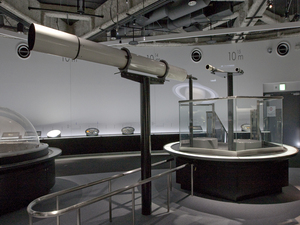Nagoya City Science Museum
TOP > Exhibition Guide > Keyword Search > Starting with "M" > mechanism > Extending the Eye
Extending the Eye

Purpose of Exhibition
Try and touch telescopes and check out the difference of diameter, type and magnification.


Additional Knowledge
[Telescope Magnification and Diameter]
The performance of a telescope depends on the diameter (aperture) of its lens or mirror. You have to choose the proper magnification according to your target or purpose. If you use higher magnification, the image will become darker and the field of view become smaller. One with a large diameter can collect more light, thus providing higher magnification without darkening the image. By using one with small diameter, you cannot get high magnification, but instead you have a wide field of view. You need to select one so to make it suitable for your purpose. If you want to observe planets or lunar craters in detail, you may use large diameter and high magnification; or for sweeping through large nebulae or clusters, low magnification and wide field of view are preferable.
[History of the 15cm Refracting Telescope]
This 15cm refracting telescope was made by a Japanese company, NIKON. It was installed at the Higashiyama Astronomical Observatory, which was established adjacent to the Higashiyama Zoo and Botanical Gardens with a wish to “Bring Wonders of the Universe to the Citizens” in 1951. It was used for astrophotography and planetary observations. Later, it was relocated to the rooftop of this museum as the former Science and Technology Building was constructed in 1964, and had been active in occasions such as a star gazing party until 1984.
In addition to this 15cm refractor telescope, we have a 5cm Galilean telescope and 5cm Keplerian telescope. You can touch and compare the magnification and their field of view.
This page was last edited on 15 June 2022.
Article by Astronomy Section
